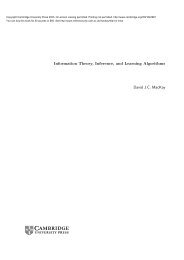Mouse Maze Project Title: Automatizing of Behavioral Experiments ...
Mouse Maze Project Title: Automatizing of Behavioral Experiments ...
Mouse Maze Project Title: Automatizing of Behavioral Experiments ...
You also want an ePaper? Increase the reach of your titles
YUMPU automatically turns print PDFs into web optimized ePapers that Google loves.
1/2<br />
<strong>Mouse</strong> <strong>Maze</strong><br />
<strong>Project</strong> <strong>Title</strong>: <strong>Automatizing</strong> <strong>of</strong> <strong>Behavioral</strong> <strong>Experiments</strong> to Reveal Memory Deficiency in <strong>Mouse</strong> Models <strong>of</strong><br />
Neurological Disorders<br />
Contact (name, email, phone): Dr. Pavel V. Belichenko, MD, PhD and Alexander M. Kleschevnikov, PhD<br />
Department <strong>of</strong> Neurosciences School <strong>of</strong> Medicine, University <strong>of</strong> California, San Diego, 9500 Gilman Drive,<br />
George Palade Labs, Room 337 MC-0649, La Jolla, California 92093-0662. pavel_belichenko@yahoo.com,<br />
Phone 858-534-0760. akleschevnikov@yahoo.com, 858-534-1089.<br />
Availability During Kick<strong>of</strong>f Week:<br />
The student team will contact each sponsor to arrange for a convenient meeting time during the kick<strong>of</strong>f<br />
week, and weekly meetings thereafter. Please indicate if you will be in-town during the kick<strong>of</strong>f week<br />
• For Winter kick<strong>of</strong>f during week <strong>of</strong> February 22-26: _YES__(yes/no)<br />
Background, Significance and <strong>Project</strong> Description: Several behavioral tests can be used to assess the<br />
cognitive and communication abilities in animals. Traditionally, T-maze alternation task, object recognition<br />
test, social interaction test and vocalization recording can be used for behavioral evaluations <strong>of</strong> mouse<br />
models <strong>of</strong> neurological disorders. Some <strong>of</strong> these approaches are currently use in our lab to revealed memory<br />
deficiency. Performing and analysis <strong>of</strong> these tests require substantial man power. Automatization may<br />
significantly increase productivity, precisions and reduce variability <strong>of</strong> results.<br />
Specific Aims: There are 3 aims in this project: 1) design and test automated apparatus for T-maze; 2)<br />
design and test automated apparatus for quantification <strong>of</strong> social behaviors; and 3) design and test apparatus<br />
for the vocalization recording. Testing <strong>of</strong> these apparatuses will be done on different mouse models.<br />
Preliminary Data and Procedures: An example <strong>of</strong> T-maze testing. Mice at age 3–4 months will be used. A<br />
modified Deacon and Rawlins protocol (Deacon and Rawlins, 2006) for a continuous alternation task in a Tmaze<br />
will be used to detect hippocampal function. The maze is made <strong>of</strong> opaque acrylic (Plexiglas) as<br />
described (Deacon and Rawlins, 2006) with an additional sliding door at the beginning <strong>of</strong> the start arm.<br />
During the test, a mouse will be placed at the beginning <strong>of</strong> the start arm, with its back to the closed sliding<br />
door. After all doors will be opened automatically, the mouse ran down the start arm to choose either the<br />
right or left goal arm. After all four legs <strong>of</strong> the mouse had entered one goal arm, sliding door to another goal<br />
arm will be closed automatically for 5 s, and then all sliding doors will be opened again automatically,<br />
allowing mice to go back to the start arm. T-maze activity will be monitored until mice finished 10<br />
alternations. This procedure will be repeated for 3 consecutive days, for a total <strong>of</strong> 30 trials. The spontaneous<br />
alternation score will be defined as the number <strong>of</strong> left–right and right–left alternations, expressed as a<br />
percentage <strong>of</strong> the total number <strong>of</strong> possible alternations during the session. Results will be averaged for both<br />
alternation scores and time spent.<br />
Final Outcome: While finishing the project, students will have great lab experience and knowledge <strong>of</strong><br />
designing and conducting experiments. Results <strong>of</strong> experiments may be used in future publications.<br />
Literature: Belichenko NP, Belichenko PV, Kleschevnikov AM, Salehi A, Reeves R, Mobley WC. (2009)<br />
The “Down syndrome critical region” is sufficient to confer behavioral, neurophysiological, and synaptic<br />
phenotypes characteristic <strong>of</strong> Down syndrome. J Neurosci. 29(18):5938-5948.<br />
Skills Used in <strong>Project</strong>: There are no any citizenship or confidentiality issues required <strong>of</strong> the student team.<br />
Budget<br />
The budget for each project is a not-to-exceed amount, which will be billed to the sponsor at completion <strong>of</strong><br />
the project.
Equipment and Parts $1000<br />
Machine Shop Expenses (reduced from $1500 for university sponsors) $1000<br />
Total $2000<br />
Sponsor's Fiscal Contact Person (Name, email, phone): Susan Quay, squay@ucsd.edu, 858-534-9434<br />
Return to: Dr. Nathan Delson, Director MAE Design Center, UC San Diego ndelson@ucsd.edu (858) 534-<br />
0655<br />
2/2
















